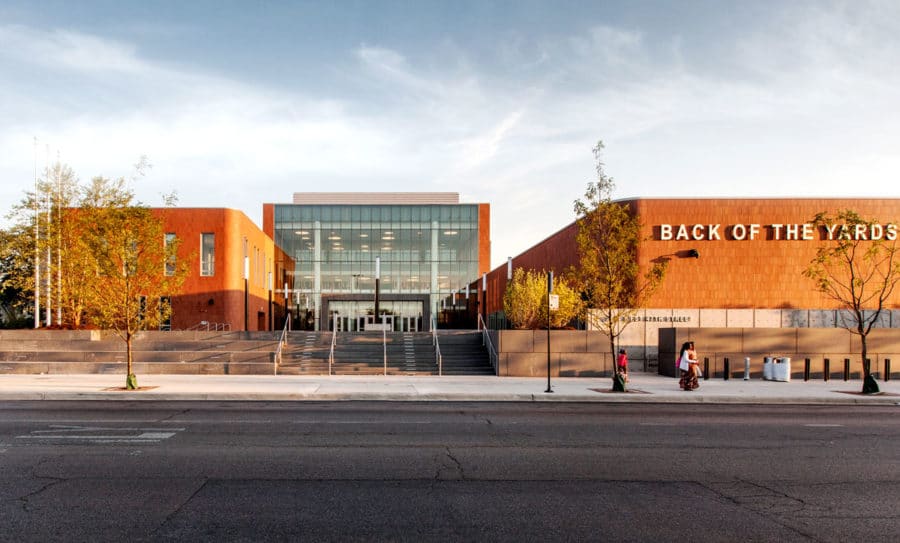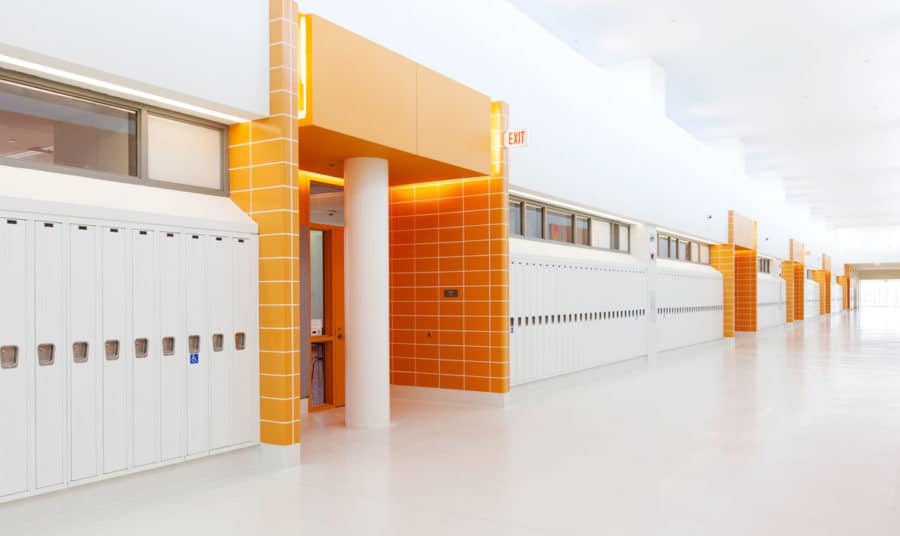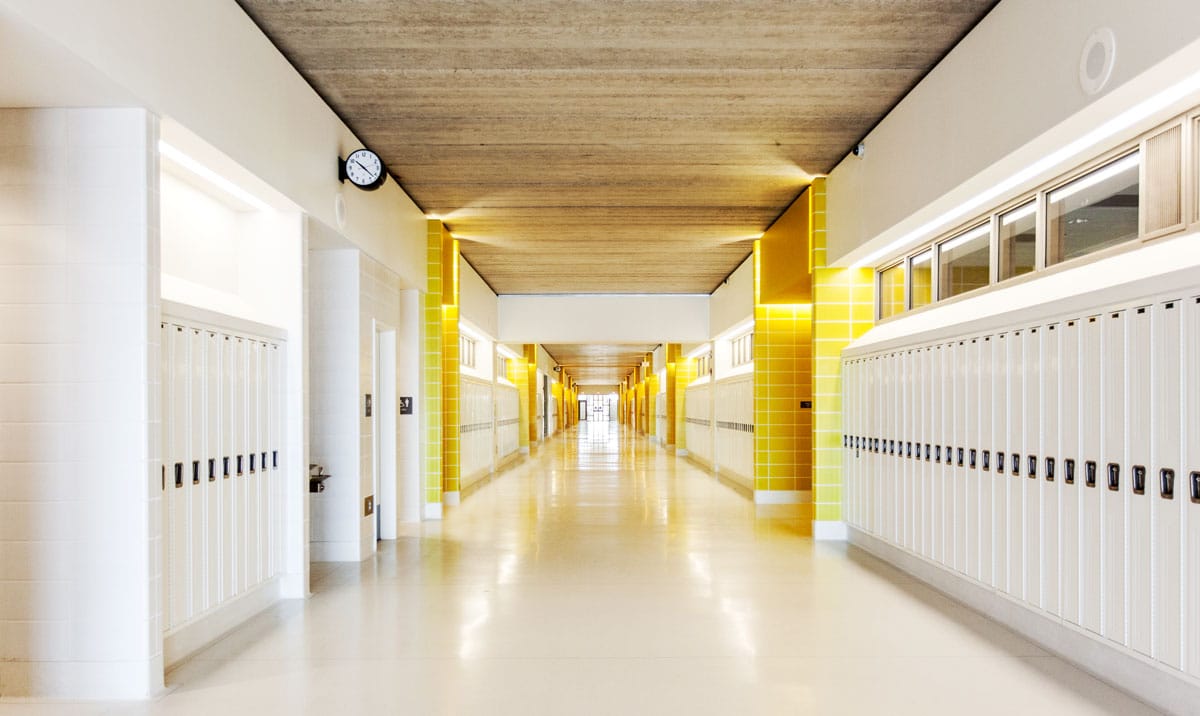Story at a glance:
- SCHOTT’s innovative glass production process leads to better, more beautiful product.
- The first floated glass-ceramic was introduced to the industry by SCHOTT in 2007.
SCHOTT has been in the glass industry for more than 130 years and leads development in areas of specialty glasses, materials, and advanced technologies.
Today SCHOTT’s PYRAN® Platinum fire-rated glass-ceramic can be found improving and beautifying buildings all over the world.
PYRAN Platinum’s innovative Microfloat process combines aesthetics and safety, expanding the limits of building design. These are just some of the benefits.
1. Smooth Surfaces

PYRAN Platinum glass-ceramic was not installed in the entrance. Photo courtesy of STL Architects
In 2007 SCHOTT introduced the world to the first floated glass-ceramic—PYRAN Platinum. It continued to be the only floated glass-ceramic as of 2018, produced using the company’s unique Microfloat process, so you won’t find the blemishes or distortions you see with glass produced using competitors’ rolling process, which can leave imperfections as the glass rolls over steel rolls.
SCHOTT floats the molten glass ribbon on an inert bed of liquid tin, cooling it slowly without any mechanical contact that could mar the surface. Competitors often need to polish their glass afterward to try to remove distortions, adding to the cost.
“PYRAN Platinum fire-rated glass-ceramic is the only glass-ceramic designed specifically for architectural applications,” says Dan Poling, sales manager for PYRAN.
The industry itself is small—three glass-ceramics manufacturers exist in the world. Poling says competitors’ fire-rated glass-ceramics are a byproduct of other products, like cooktop stoves, whereas SCHOTT’s fire-rated glass-ceramics are made to be just that.
“We developed PYRAN Platinum specifically for fire-rated architectural applications in North America.”
2. Even Thickness
Because the molten glass is truly floating, you’re also guaranteed an even thickness.
Poling says it’s difficult to control thickness with the rolling process, as the molten glass doesn’t have time to spread out evenly like it does when floating.
“The best products you can buy are floated products. They’re more economical, you get a better surface quality, and you get a better, true thickness,” he says.
3. Neutral Color
Traditional fire-rated glass-ceramics have an orange, yellow, or brown hue, but PYRAN Platinum glass-ceramics do not, and architects love it. “Ours is more gray-green, providing a neutral color rendition,” Poling says.
When you look through a competitor’s glass-ceramic that’s colored yellow, orange, or brown, everything appears an unnatural color. “When people see ours the first thing they say to us is, ‘Oh, this looks so much more clear.’ When they look through a product that’s more gray-green, it doesn’t mutate the colors we see, so the sky looks blue, the grass looks green.”
4. Distortion-Free Finish

Photo courtesy of STL Architects
PYRAN Platinum batches are smaller than those of soda lime glass, too, which makes the temperature easier to control. “We’re controlling the heat process, and being able to flow the glass on the bed of liquid tin allows us to have less deviation in the end product,” says Kim Kennell, marketing manager.
While the process for soda lime glass can produce melts up to 500 to 600 tons of glass, SCHOTT produces 20 to 40 tons of glass. The raw materials used in PYRAN Platinum are heated to temperatures far higher than those used in common soda lime glass. The temperature is then slowly decreased. This slow cooling enables the surface of the glass to remain smooth with a distortion-free finish.
“Soda lime glass you see everywhere—it’s mass produced. This is not mass produced. It’s very customized,” Poling says.
5. Fire-Rated
PYRAN Platinum fire-rated glass-ceramics prevent the spread of fire, hot gases, and smoke and are UL certified for up to 90 minutes in windows and 180 minutes in doors. Even under high thermal loads, the glazing stays transparent, ensuring a burning building can be safely evacuated.
“We are fire-rated for up to three hours,” Poling says. “Our glass-ceramics withstand temperatures up to 1,900 degrees.”
While schools and medical facilities are common projects with demands for fire-rated glass, architects need it for a myriad of buildings, and you’re likely to see it in any number of applications without even realizing it. Anytime there’s a building with a common wall with two different businesses or design purposes with visual separation, you need fire-rated glass.
6: Large Sheet Sizes
Using the Microfloat process also allows PYRAN Platinum to offer the largest sheet size on the market, Poling says. Larger sheets of glass give architects more design flexibility and freedom. “You’re not constraining an architect,” Poling says. “Architects and people in general always want bigger windows and more natural light.”
Fire-rated glass may not be at the top of architects’ lists, but it’s a necessity that can be used in beautiful ways. “It allows us to open things up, to get more vision and daylight into our spaces, and that’s great. People want more and more of that.”
7. Sustainability
PYRAN Platinum is made without toxic heavy metals like antimony or arsenic, which are normally used as refining agents in the industry. All incoming raw materials must meet strict tolerances for contamination.
SCHOTT uses solar panels and gray water at its facilities, too, and focuses extensively on recycling. SCHOTT currently recycles its internal cut-off and scrap material as cullet in its glass melts. The melt tank uses 40 to 50% cullet.
SCHOTT also has 36 cutting stations in North America, so you can get fire-rated glass-ceramics close to home. This reduces lead time and cuts back on energy wasted shipping glass across the country, as you can get the product locally.
Recycling glass-ceramic also isn’t easy—it requires a much higher heat input for remelting as compared to consumer glass products. No public programs exist in the US for local glass-ceramic recycling, so in 2010 SCHOTT launched its own recycling program to minimize the amount of glass-ceramic in North America landfills, taking backdrops and unused material from their North American warehouse and all PYRAN glass-ceramic from North American fabricators to reuse them as cullet.

